Categories
Other Shop Pages
Currency
The Isle of Skye
The Isle of Skye (An t-Eilean Sgitheanach) is one of the larger islands lying off the northwest coast of Scotland. being part of the group of islands known as the Inner Hebrides Until 1995 travel from the mainland was by a short ferry crossing but a bridge now allows direct road access, and in 2004 after many protests from users the crossing was made toll free. Although not far north of the main cities of Scotland it takes a long time to drive there on slow, winding roads. Even after a considerable drive from the south to Glasgow, the island is still some 3-4 hours drive further away!
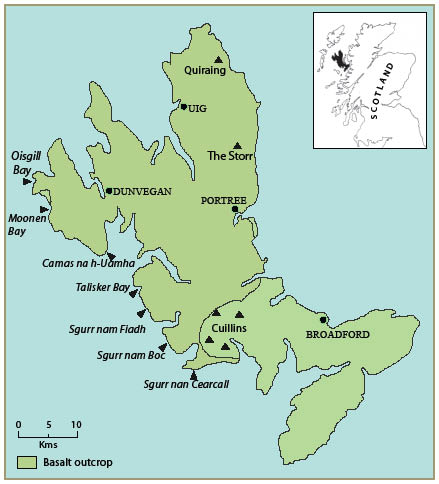 Mineralogy
MineralogyThe Isle of Skye, has many zeolite localities with much of the central and northern parts of the island composed of basalt. The variety and quality of the crystal groups found are exceptional for Great Britain and of great interest to Scottish mineral collectors and mineralogists. Minerals species from a number of collection sites on the island include apophyllite,chabazite, thomsonite, heulandite, gyrolite, levyne, phillipsite, analcime, stilbite, calcite, cowlesite, scolecite, stellerite, erionite, prehnite, epidote, quartz, connellite and epistilbite. Native copper mineralisation with copper secondary minerals such as malachite and connellite may also be found.
The Scottish mineral collector Matthew Forster Heddle brought the Isle of Skye to the attention of mineralogists with the publication (posthumously) in 1901 of the two volume Mineralogy of Scotland.
Of particular interest were the many zeolite localities he listed in the Tertiary volcanic lavas which form the predominant part of the island. The lavas, originally up to 6,000 metres thick, are in places highly vesicular and whilst in general “Poona” size crystals can’t be found, the variety and quality of the crystal groups are exceptional for Great Britain. His collection, amassed from his many explorations to mineral sites throughout Scotland, can be seen at the Royal Scottish Museum, Edinburgh.
Of particular interest were the many zeolite localities he listed in the Tertiary volcanic lavas which form the predominant part of the island. The lavas, originally up to 6,000 metres thick, are in places highly vesicular and whilst in general “Poona” size crystals can’t be found, the variety and quality of the crystal groups are exceptional for Great Britain. His collection, amassed from his many explorations to mineral sites throughout Scotland, can be seen at the Royal Scottish Museum, Edinburgh.
Permission to visit inland sites should always be obtained and checks made as to whether a particular site is designated as an SSSI.
Mineral Locations
Moonen Bay
Pale green and clear apophyllite to about 20mm, (among the best from the Isle of Skye),
chabazite, thomsonite, heulandite, gyrolite, levyne, native copper, phillipsite, analcime, stilbite, calcite
(light cream to dark brown), cowlesite, scolecite, stellerite, erionite
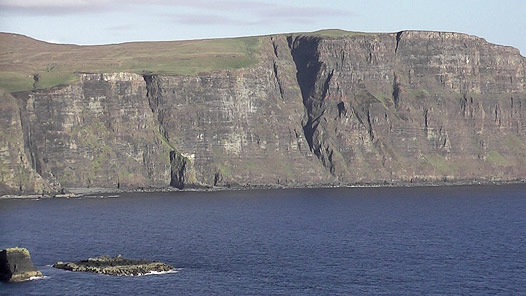
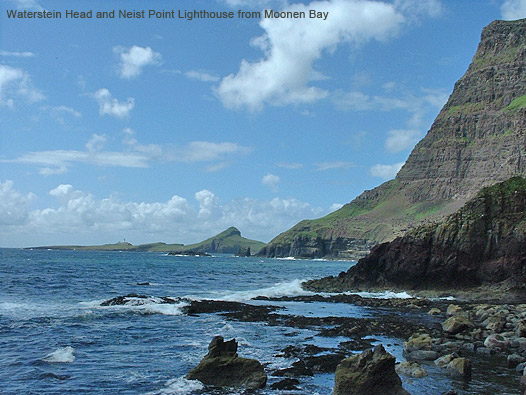
chabazite, thomsonite, heulandite, gyrolite, levyne, native copper, phillipsite, analcime, stilbite, calcite
(light cream to dark brown), cowlesite, scolecite, stellerite, erionite


Sgurr Nam Boc
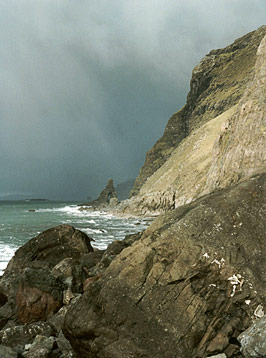
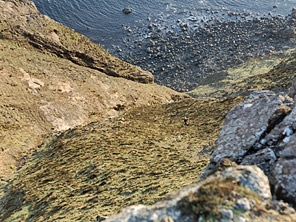
Sgurr Nam Boc is one of the most difficult places to get to, with a near vertical climb down to
the beach from the 200 metre high cliffs. However in the past it has produced probably the best
Skye Stilbite and heulandite specimens. Other species occuring here are quartz, epistilbite and
apophyllite.
the beach from the 200 metre high cliffs. However in the past it has produced probably the best
Skye Stilbite and heulandite specimens. Other species occuring here are quartz, epistilbite and
apophyllite.
Camas na h-Uamha
A little known locality, calcite specimens occur here
along with unusual specimens consisting of small stilbite crystals fomed over slender elongated scalenohedral calcite crystals
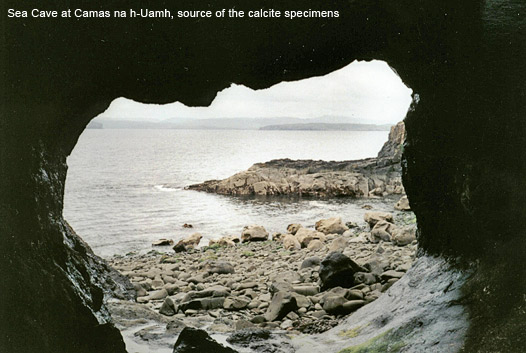
Edinbane
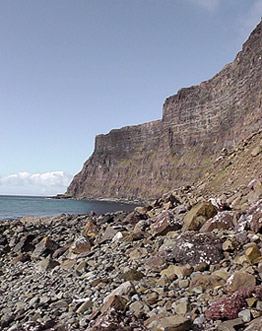
Road cuttings near here have in the past produced good specimens of the rare zeolite stellerite plus stilbite and
erionite
Oisgill
Probably best known for levyne, cowlesite and fine sprays of natrolite. Also good analcime and chabazite specimens, with somewhat rarer examples of stilbite usually white rather than cream, heulandite & phillipsite.
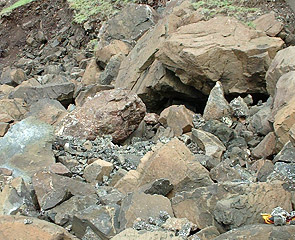
Ollisdal Geo
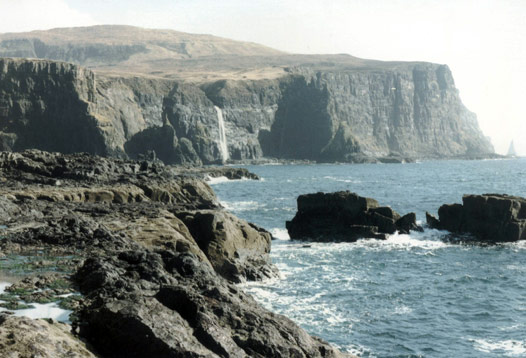
Excellent green and brown apophyllite specimens at this remote
location. Previously fine distorted beds of calcite crystals were found here.
Sgurr Nan Cearcall
Some of the best prehnite from the Isle of Skye occurs here of a pale turquoise colour and the proximity of this location to the Cuillin Metamorphic Aureole has given rise to epidote, quartz, calcite and native copper mineralisation with copper secondary minerals including malachite and connellite.
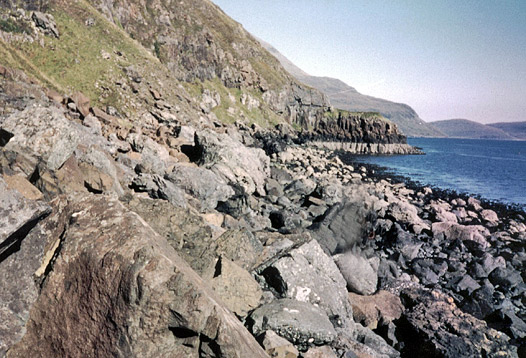
Sgurr Nam Fiadh
Another difficult to get to beach location. Has produced stilbite to rival those from Sgurr nam Boc.
Mesolite and chabazite also occur here.
Mesolite and chabazite also occur here.
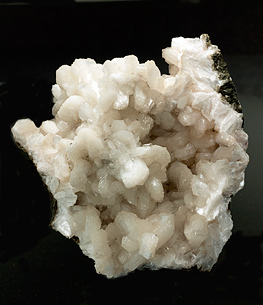
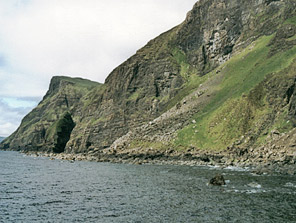
< 12x12cm Stilbite specimen from Sgurr Nam Fiadh
Talisker Bay
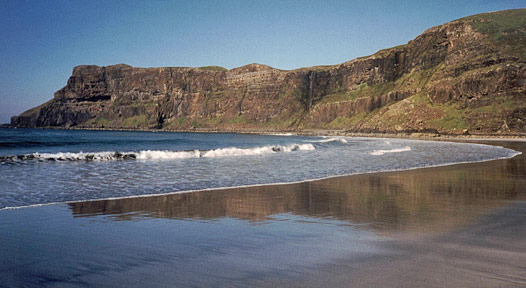
Talisker Bay is a pleasing seascape and full of interest. One of the first documented visits to the bay
in 1773, was by James Boswell and Dr Samuel Johnson the author of the first English dictionary. In
his book A Journey to the Western Isles he described Talisker Bay thus “Talisker is the place beyond
all that I have seen, from which the gay and the jovial seem utterly excluded; and where the hermit
might expect to grow old in meditation, without possibility of disturbance or interruption. It is situated
very near the sea, but upon a coast where no vessel lands but when it is driven by a tempest on
the rocks.” Obviously in those days landscapes were seen through different eyes! Mineralogically,
excellent specimens of honey coloured calcite have been found usually accompanied by analcime or
chabazite. The chabazite can be pale pink, cream or white. Epistilbite occurs near the
sea stack.
The Storr and Quiraing
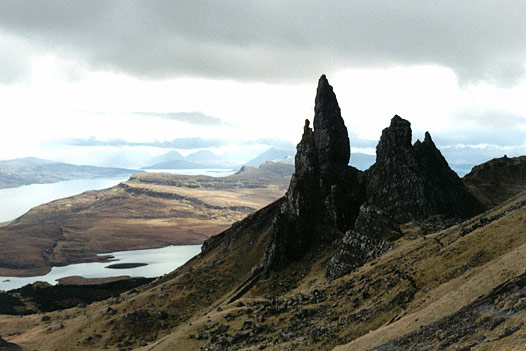
Inland on the north of the island the famous landscapes of the Storr and Quirang zeolites occur the
most common being stilbite, chabazite and apophyllite.
Recent Items for Sale
Minerals of the English Midlands

Minerals of the English Midlands

Mailing List
Interested in our mailing list? Get in touch via the email address on our contact page and we will add you to the mailing list.


